Jump to a Member Profile

DAYNA LOYD AVERITT, MSCI, PHD
Dr. Averitt earned her BA in Biopsychology at the University of Texas at Austin (2001), and PhD in Neuroscience (2008) from Georgia State University under the mentorship of Anne Murphy studying the neural correlates of sex differences in morphine analgesia. She then completed postdoctoral training at the University of Texas Health Science Center in San Antonio (2011) under the mentorship of Ken Hargreaves studying serotonergic modulation of the TRPV1 population of trigeminal nociceptors. Dr. Averitt then worked as a Principle Investigator at the US Army Institute of Surgical Research for two years studying neuropathic and burn pain within the context of military pain management needs. In 2013, Dr. Averitt joined the faculty at the Texas Woman’s University as an Assistant Professor. Research in the Averitt Lab focuses on sex differences and the effect of gonadal hormones on neural mechanisms of pain and analgesia. The Averitt lab is also interested in the discovery of novel plant extracts with analgesic properties as potential phytomedicines for pain.
View Dr. Averitt’s profile at Texas Woman’s University

AMBER HARRIS BOZER, PHD
Dr. Bozer is a Dolorologist. Her Behavioral Neuroscience and Psychophysiology lab investigates pain behaviors and cognition using electrophysiological methods including EEG. Approach-avoidance conflicts are of interest, including for pain and vaccine aversion. We also investigate the effects of using cannabinoids as analgesics. She has a tertiary research interest in the scholarship of teaching and learning, specifically the integration of primary literature into undergraduate neuroscience courses.
She is a research administrator, with experience including lab management, breeding colony management, chemical inventory management, service as a Faculty Research Fellow, Director of Faculty and Student Research, and more recently, Director of Scholar Development at a medium-sized institution. Less formally, my office is a revolving door for research learning and support.
View Dr. Bozer’s profile on her lab website
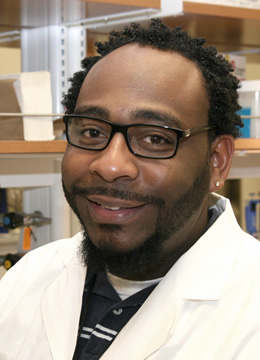
MICHAEL BURTON, PHD
Dr. Burton is an Assistant Professor in the Systems Neuroscience Program at the University of Texas at Dallas. His research focus is how the immune system modulates peripheral sensory neurons to regulate pain and energy homeostasis. Michael received his BS and PhD in Immunophysiology and Behavior at the University of Illinois at Urbana-Champaign, where his dissertation work uncovered IL-6 signaling mechanisms during neuroinflammation and aging. He then moved to Dallas, TX to begin his postdoctoral fellowship work in the Department of Hypothalamic Research at UT Southwestern Medical Center with Joel Elmquist. There Michael gained skills in molecular genetics, neuroendocrinology, and neuroanatomy; in a study focused on how peripheral ganglia recognized dietary components.
He then moved to Ted Price’s laboratory on the UT-Dallas campus to focus on how immune cells influence the transition to chronic pain. It was the fusion of these 2 experiences that formed the basis of a recently awarded K22 Advanced Postdoctoral Career Transition Award. He transitioned to a tenure-track position in the summer of 2017. He believes in order to traverse the gap between basic research and clinical application to the patient, we must realize and appreciate pre-clinical research. He is excited at the notion to play a role in this process, and help humankind through his research in pain development, obesity, and metabolic disorders that we deal with every day.
He also enjoys the opportunity to listen to great music, cook a great meal, and watch/play football and basketball. His long-term goal is to develop a leading research program and dedicate his career to studying neural control function, as well as mentor future undergraduate, graduate, and postdoctoral trainees.
View Dr. Burton’s lab at UT Dallas
— Return to Top —

RYAN BUTLER, PHD
My research laboratory is in a unique position to investigate and develop treatments for several disease conditions which are of importance to public health. The lab will be able to continue on lines of research related to adaptive pain, chronic pain, and co-morbid conditions. Furthermore, we will develop a line of research in the UTSW Viral Vector Facility to develop gene therapy-based treatments for a number of psychiatric and neurodevelopmental conditions.
Towards an understanding of adaptive and maladaptive pain along with co-morbid conditions
We are currently performing experiments 1) to determine the neural processes involved in adaptive pain, pain suppression and the responses due to the threat of pain and 2) to measure the neurobehavioral and molecular changes that occur because of chronic pain with the ultimate goal of reversing these maladaptations. These two broad research goals will have smaller focal points including the determination of the neurocircuitry involved in stress-induced analgesia (SIA), measurements of electrophysiological and molecular components of specific neuronal subtypes with acute/chronic pain and the behavioral evolution of addiction induced by chronic pain. The ultimate goal of this research will be to increase the understanding of natural endogenous pain suppression, the etiology of chronic pain disease and the progression to drug and alcohol addiction.
View Dr. Butler’s profile at UT Southwestern
— Return to Top —

ZACHARY CAMPBELL, PHD
DNA makes RNA and RNA makes protein. This deceptively simple process is subject to complex regulation that is instrumental in mediating cellular responses to environmental cues. We are interested in understanding how regulatory information encoded by untranslated regions present in mRNA relates to pain amplifying behavior. To this end, we utilize genome-wide approaches and apply this information to the design of mechanism-based inhibitors of RNA-protein interactions. Our goal is to characterize essential post-transcriptional controls that are required for plasticity changes in nociceptive neurons.
View Dr. Campbell’s lab at UT Dallas
— Return to Top —

MUNMUN CHATTOPADHYAY, PHD
Munmun Chattopadhyay received her PhD in Neurosciences from Jiwaji University, Gwalior, India. Shortly after her PhD, she joined University of Pittsburgh as a post-doctoral fellow in the Department of Neurology. She became a Research Assistant Professor in the Department of Neurology at the University of Michigan in 2010. Dr. Chattopadhyay joined Center of Emphasis in Diabetes and Metabolism at the Texas Tech University Health Sciences Center, El Paso as an Assistant Professor in April, 2014.
Her work focuses on understanding the pathogenesis of painful neuropathies and development of novel treatments which involve the regulation of inhibitory neurotransmitter receptors and ion channel trafficking. Currently, her lab is investigating on the effect of increased neuroimmune activation in the pathophysiology of Type 1 and Type 2 diabetic painful neuropathies. These studies emphasize on identifying the specific cytokines/chemokines and their interaction with voltage-gated ion channels which may lead to targeted therapeutic interventions for diabetic sensory neuropathy. Dr. Chattopadhyay’s lab is also involved in studying the role of exercise and other alternative approaches that can alleviate the development of these complications.
View Dr. Chattopadhyay’s profile at Texas Tech University Health Sciences Center, El Paso
— Return to Top —
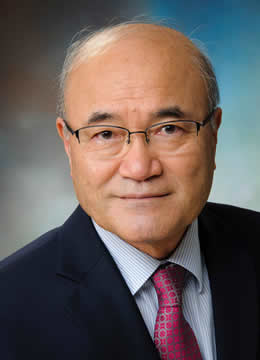
JIN MO CHUNG, PHD
Dr. Chung received his PhD in Physiology from Loyola University of Chicago in 1977 and received his post-doctoral training in neurophysiology from Dr. William D. Willis, Jr. at the University of Texas Medical Branch, Galveston, TX. Dr. Chung’s research is focused on the mechanisms of chronic pain, especially neuropathic pain. His most notable contribution to the field of pain is his rodent model of chronic pain referred to as the “spinal nerve ligation (SNL)” model, nicknamed the “Chung Model.” Currently his specific research focus is on the synaptic plasticity of pain transmission pathways, involvement of reactive oxygen species in chronic pain and development of various pain treatment strategies. Dr. Chung has published more than 150 papers in peer reviewed journals. These papers have been cited more than 19,000 times in the literature. Dr. Chung’s research has been supported by NIH research awards for over 30 years, with multiple RO1s and Program Project Grants.
View Dr. Chung’s page at the University of Texas Medical Branch at Galveston
— Return to Top —
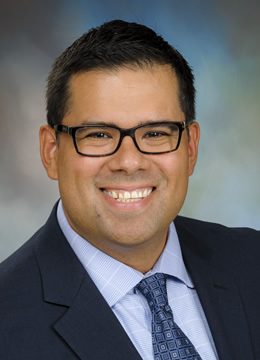
ROGELIO CORONADO, PT, PHD
Dr. Coronado is an Assistant Professor in the Department of Physical Therapy and Department of Orthopaedic Surgery and Rehabilitation at the University of Texas Medical Branch (UTMB). He is a K12 Scholar through an NIH-funded Rehabilitation Research Career Development grant (HD-055929) from UTMB’s Division of Rehabilitation Sciences. Dr. Coronado is a licensed physical therapist who obtained his Master of Physical Therapy degree from Texas Tech University Health Sciences Center (2007) and completed post-graduate clinical residency and fellowship training at the University of Wisconsin (2008) and Duke University (2009), respectively. He completed his PhD at the University of Florida in 2014, followed by a postdoctoral research fellowship at Vanderbilt University Medical Center in 2016. His current research focuses on improving musculoskeletal pain outcomes through a precise understanding of therapeutic targets and mechanisms and by clinical integration of behavioral-based interventions in physical therapy. He has obtained funding for his work from the American Physical Therapy Association, Cervical Spine Research Society, and Foundation for Physical Therapy.
View Dr. Coronado’s page at Vanderbilt University Medical Center
— Return to Top —

CARMEN DESSAUER, PHD
Dr. Dessauer received her BS and PhD in Biochemistry from Louisiana State University. During her postdoctoral training with Dr. Alfred Gilman, at UT Southwestern Medical Center in Dallas, she examined fundamental biochemical properties of adenylyl cyclase (AC). Adenylyl cyclase synthesizes the intracellular second messenger cyclic AMP, which plays a key role in acute and chronic pain responses. Many hormones and drugs, including inflammatory and stress hormones, mediate their actions by binding to G protein-coupled receptors that increase cyclic AMP production, while drugs such as opioids relieve pain, in part, by reducing cAMP production. A major question in her laboratory is how cAMP signaling functions to maintain chronic pain and why the response to opioids is dampened after spinal cord injury. Her laboratory uses biochemical, molecular, and functional studies to identify drugs and drug targets that can block signaling pathways that maintain chronic pain states. Dr. Dessauer is a fellow of the American Association for the Advancement of Science (AAAS), a member of the NIH Advisory Council for the Institute of General Medical Sciences, a steering committee member for the Gulf Coast Consortium program on Translational Pain Research, and Director of a NIH funded T32 graduate program, “Training Interdisciplinary Pharmacology Scientists.”
View Dr. Dessauer’s page at the University of Texas Health Science Center at Houston
— Return to Top —

PATRICK DOUGHERTY, PHD
The most recent work in my laboratory is focused on gaining an understanding of the neurochemical and physiological mechanisms of pain in cancer patients. This research emphasizes defining pain producing mechanisms that will lead to interventions for chemotherapy-induced neuropathic pain and cancer-related hyperalgesia. The work is composed of clinical studies in patients and complementary studies conducted in laboratory animals. The goal of the clinical studies is to define the sensory nerve fibers that are involved in the generation of neuropathic pain as a consequence of cancer and cancer chemotherapy. This research line is the first where quantitative sensory examination techniques have been combined with skin biopsy to explore the specific nerve fiber types that are impaired in patients with chronic chemoneuropathy. This line of work was also the first to show that cancer itself is a contributing factor to neuropathy prior to any cancer treatment and that latent differences in distal innervation is another important factor. Clinical intervention and prevention trials have also recently received extramural funding. Success in this research will allow patients to undergo more aggressive therapy and therefore may improve on patient survival. Prevention and treatment of neuropathic pain will also increase the quality of life of patients and should hasten the return to productivity of cancer survivors. The most recent clinical studies have focused on the physiological, biochemical and anatomical changes occurring in human dorsal root ganglion (DRG) neurons with the development of chronic pain. The work is in collaboration with Neurosurgery where DRG will be sacrificed during surgery for metastases to the vertebral bodies. This provides a unique opportunity to collect this tissue for detail laboratory study and allows a direct comparison between similar studies in experimental animals.
View Dr. Dougherty’s page at The University of Texas MD Anderson Cancer Center
— Return to Top —

GREG DUSSOR, PHD
Greg Dussor is an Associate Professor in the School of Behavioral and Brain Sciences at The University of Texas at Dallas. He received a PhD in Pharmacology from The University of Texas Health Science Center at San Antonio in 2002. Following his PhD studies, he did postdoctoral training from 2003-2007 at the Vollum Institute on the campus of The Oregon Health & Science University in Portland and in 2007, joined the Faculty in the Department of Pharmacology at the University of Arizona in Tucson. He remained on faculty there until joining UT Dallas in 2014.
His laboratory uses preclinical models of headache to investigate mechanisms that lead to activation/sensitization of afferent nociceptive signaling from the meninges. He has published over 50 peer-reviewed manuscripts on pain and headache and his work has been funded by the NIH, Migraine Research Foundation, National Headache Foundation, and several industrial sponsors.
Dr. Dussor received a Future Leaders in Pain Research Award from the American Pain Society, he is on the Editorial Boards for PAIN, PAIN Reports, and Headache, and he is a member of the Medical Advisory Board for the Migraine Research Foundation.
View Dr. Dussor’s faculty profile at UT Dallas
— Return to Top —

PERRY FUCHS, PHD
My overall research program explores the basic, underlying central and peripheral nervous system mechanisms associated with rewarding and aversive stimuli. Experimental models, such as peripheral inflammation and nerve injury, are associated with a wide variety of behavioral responses that reflect the underlying dimensions of pain. For instance, a noxious stimulus usually engages specific peripheral and central neural mechanisms, causing conscious sensations that consist of judgments regarding the location and extent of tissue damage. In addition, there is also an engagement of affective and motivational mechanisms as well as an induction of somatic and autonomic responses. Through the use of various experimental models, central mechanisms of pain processing related to the sensory, affective/motivational and cognitive/evaluative dimensions are elucidated using focal electrical stimulation, microinjection, and lesion techniques.
View Dr. Fuch’s profile at the University of Texas at Arlington
— Return to Top —

MICHAEL GALKO, PHD
Michael Galko received a PhD In cell biology from UCSF with Dr. Marc Tessier-Lavigne and performed postdoctoral work with Dr. Mark Krasnow in the Biochemistry Department at the Stanford University School of Medicine. He has been on the faculty at the University of Texas MD Anderson Cancer Center since late 2005.
The Galko Laboratory is interested in how organisms respond to tissue damage. Multicellular organisms have evolved a variety of cellular and behavioral responses to cope with tissue damage and facilitate tissue repair. For instance, wound closure is aimed at restoring structure and function to the damaged tissue(s). By contrast, nociceptive (pain) sensitization is aimed at fostering behaviors that protect the organism from further injury.
Local alterations in nociception (pain sensation) are a hallmark of tissue damage in vertebrate organisms. Nociceptive sensitization can involve a lowering of the pain threshold such that previously non-noxious stimuli are perceived as painful (allodynia), as well as a faster or exaggerated response to supra-threshold stimuli (hyperalgesia). Sensitization serves to foster escape behaviors that protect sites of tissue damage while they heal.
We have shown that both hyperalgesia and allodynia develop following UV irradiation in Drosophila larvae and that allodynia depends on a conserved tumor necrosis factor (TNF)-like cytokine that is produced by the irradiated epidermal cells and on a TNF receptor-like protein present on nociceptive sensory neurons (Current Biology, 2009). Since this initial demonstration that nociceptive sensitization can be modeled in Drosophila we have been using the full genetic power of this system to identify new assays (JoVE, 2012) and new genes (Current Biology, 2011) that regulate nociceptive sensitization.
Our most interesting finding to date is that the Hedgehog signaling pathway, which regulates diverse aspects of patterning and cell fate specification during development, also plays a conserved role in regulating the responses of sensory neurons to painful stimuli (Current Biology, 2011). We are continuing to study the mechanisms of TNF- and Hh-induced sensitization (eLife 2015; Cell Death and Disease 2017), to screen for new genetic regulators of thermal allodynia and hyperalgesia, and to develop new assays for how Drosophila larvae respond to noxious cold (Current Biology 2016), harsh mechanical touch, chemicals, and chemotherapy drugs.
View Dr. Galko’s profile at the University of Texas MD Anderson Cancer Center
— Return to Top —

STACEY GORNIAK, PHD
Stacey L. Gorniak, Assistant Professor. Dr. Gorniak the current director of the Center for Biomechanics Research (CNBR) at the University of Houston. Dr. Gorniak completed her post-doctoral fellowship at the Cleveland Clinic in Biomedical Engineering. She earned her MS and PhD in Kinesiology, focused in Biomechanics and Motor Control (with a minor in Statistics) from the Pennsylvania State University. Dr. Gorniak’s research interests focuses on evaluating both the central and peripheral contributions to sensory, motor, and cognitive deficits due to chronic health conditions and movement disorders.
View Dr. Gorniak’s profile at the University of Houston
— Return to Top —

PETER GRACE, PHD
Peter Grace is an Assistant Professor in the Division of Anesthesiology, Critical Care & Pain Medicine, at the University of Texas MD Anderson Cancer Center. Dr. Grace obtained his B. HlthSc (Hons) and PhD degrees from the University of Adelaide Australia. He undertook doctoral training in Medicine, in the labs of Profs Paul Rolan and Mark Hutchinson, focusing on the role of peripheral immune cells in neuropathic pain. He was then an NHMRC Postdoctoral Fellow at the University of Colorado Boulder in the lab of Prof Linda Watkins, where he investigated the neuroimmune mechanisms responsible for the transition from acute to chronic pain. The Grace Lab aims to understand the neuroinflammatory mechanisms that drive chronic pain, in order to identify new treatment strategies.
View Dr. Grace’s page at The University of Texas MD Anderson Cancer Center
— Return to Top —

JAMES GRAU, PHD
Our research currently explores how pain signals affect recovery after spinal cord injury (SCI). Evidence suggests that nociceptive input soon after injury has a destructive effect that increases cell loss at the site of injury and sets the stage for chronic pain. We are exploring the neurobiological mechanisms that underlie this effect using an animal (rat) model. Other work is examining how environmental relations and learning affect the processing of nociceptive signals within the spinal cord. Our work has shown that nociceptive stimuli that occur in an unpredictable/uncontrollable manner sensitize nociceptive circuits. Stimuli that occur in a controllable and/or predictable manner do not induce nociceptive sensitization. Indeed, controllable/predictable stimulation can induce an opponent process that inhibits the development of nociceptive sensitization. We are also exploring how SCI affects GABAergic systems within the spinal cord. Evidence suggests that severe injuries can bring about a shift in GABA function in the caudal tissue that leads to GABA having an excitatory (rather than inhibitory) effect. This change in function has been related to the loss of descending serotonergic fibers and the co-transporter KCC2. For a recent review of our work, see Grau et al., 2017, When pain hurts: Nociceptive stimulation induces a state of maladaptive plasticity and impairs recovery after spinal cord injury. Journal of Neurotrauma, 34, 1873-1890.
James W. Grau is the Mary Tucker Currie Professor of Psychology and Neuroscience at Texas A&M University. His research is funded by grants from NINDS and the Craig Neilsen Foundation.
View Dr. Grau’s profile at Texas A&M University
— Return to Top —

JOSÉE GUINDON, PHD
Dr. Josée Guindon is a newly appointed Assistant Professor in the Department of Pharmacology and Neuroscience at Texas Tech University Health Sciences Center. She has obtained her Doctorate in Veterinary Medicine, Master and PhD from Université de Montréal. She did her post-doctoral studies at University of Georgia and has received a substantial post-doctoral fellowship from the Fonds de la Recherche du Québec en Santé (FRQS). She has already published more than 32 manuscripts and has also first-authored 5 book chapters. She has won several prestigious awards since the beginning of her career and has been invited more than 30 times to give a seminar at local and international conferences.
Dr. Guindon is an expert in the behavioral, pharmacological, biochemical and transgenic analysis of pain mechanisms, using various pain models. She has greatly contributed and pioneered, virtually by herself, neural and brain endocannabinoid mechanisms that regulate and modulate pain, thus opening up new and novel understandings of the ways in which pain is transmitted through the nervous system and opening up new and novel approaches to the pharmacological management of pain.
View Dr. Guindon’s page at Texas Tech University Health Sciences Center
— Return to Top —
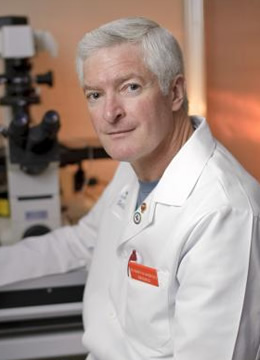
KEN HARGREAVES, DDS, PHD
Ken Hargreaves received his DDS from Georgetown University School of Dentistry, his PhD in physiology from the Uniformed Services University of the Health Sciences in Bethesda, MD, and completed a post-doctoral fellowship in clinical and basic pain research at the NIH, and a residency in endodontics from the University of Minnesota. He joined the University of Texas Health Science Center at San Antonio in 1997, as professor and Chair of the Department of Endodontics, and is jointly appointed as a professor in the Departments of Pharmacology, Physiology and Surgery in the Medical School. His area of research focuses on the pharmacology of pain and inflammation. He has served as PI or co-PI on more than $75 million in NIH research grants and has received an NIH MERIT Award and the 2013 UTHSCSA Presidential Distinguished Senior Research Scholar Award. He currently holds the USAA Foundation President’s Distinguished University Endowed Chair in Neurosciences. Ken has published 200 papers, two textbooks, has five patents issued/pending.
View Dr. Hargreaves’ page at University of Texas Health Science Center at San Antonio
— Return to Top —

COBI HEIJNEN, PHD
Her work is focused on the mechanisms of neurotoxicities as a result of cancer treatment including cognitive dysfunction and pain. Her most recent work focuses on the therapeutic effects of mitochondrial protectants in mice in the prevention of cancer treatment-induced chemobrain and chemopain. She also focuses on the regenerative effects of mesenchymal stem cells to reverse established cognitive dysfunction and chemopain. Dr. Cobi Heijnen has published more than 350 peer reviewed papers. She has been the Chair of the Department of Psychoneuroimmunology and Developmental Origins of Disease in Utrecht (the Netherlands) for many years. Her current research interests also focus on translation of the knowledge obtained in her experimental studies to the neurotoxicities in cancer patients and survivors.
View Dr. Heijnen’s profile at the University of Texas MD Anderson Cancer Center Houston
— Return to Top —

MICHELLE HOOK, PHD
Michelle Hook is an Assistant Professor in the Neuroscience and Experimental Therapeutics department at the Texas A&M Health Science Center. Dr. Hook obtained her BSc (Hons) and PhD in Physiology from the University of New England in Armidale, Australia. Following her PhD studies, she did postdoctoral training at the University of Memphis and then moved to Texas A&M University where she transitioned from a post-doctoral position to a Research Associate Professor. She joined the faculty in the Texas A&M College of Medicine in 2014.
View Dr. Hook’s profile at Texas A&M College of Medicine
— Return to Top —
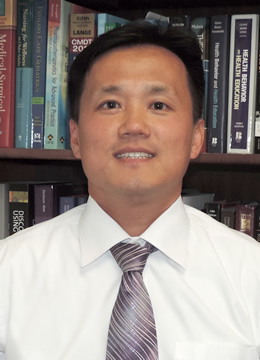
AHN “BRIAN” HYOCHOL, PHD, MSN, MS-ECE, MS-CTS, APRN, ANP-BC
My overall research goal is to establish a program of clinical and translational research that enhances health and independence in older adults using innovative technologies to optimize pain management. I have a strong background as a computer engineer as well as extensive clinical experience as a registered nurse (RN) and adult nurse practitioner board certified (ANP-BC).
As a computer engineer, I completed graduate-level courses in information science, computer network, image processing, and pattern recognition, and helped several National Institute of Health (NIH)-sponsored clinical studies develop innovative technological solutions for vulnerable populations. I also have direct patient care experience as a clinician as a Registered Nurse (RN) at the oncology unit in the tertiary inpatient setting and Advanced Registered Nurse Practitioner (ARNP) in the outpatient unit. In these environments, I have treated people with chronic pain, cancer, and other painful conditions such as musculoskeletal diseases.
My research, which is a direct result of my clinical experience, has focused on pain and symptom management, biobehavioral studies, dementia, health disparities, and biomedical informatics. Recently, I investigated the efficacy of innovative computer technologies, such as noninvasive brain stimulation, on pain and mobility performance in older adults with chronic pain with funding from the National Institute of Health (NIH)/National Institute on Aging (NIA) Claude D. Pepper Older American’s Independence Center. I also have been a co-investigator on several collaborative grants on pain and aging.
View Dr. Hyochol’s page at Florida State University
— Return to Top —

NATHANIEL JESKE, PHD
Nathaniel A. Jeske, PhD, is an Associate Professor and the Director of Research for the department of Oral & Maxillofacial Surgery at the University of Texas Health Science Center at San Antonio. His research group studies pain mechanisms in two areas: peripheral afferent signaling mechanisms that drive inflammatory pain into chronic states, and peripheral opioid receptor functionality. In these research foci, the Jeske lab aims to reduce the precipitation of chronic pain by targeting scaffolding proteins that support feed-forward hypersensitization of peripheral afferent fibers. Furthermore, they aim to increase peripheral opioid receptor analgesic responsivity, thereby increasing endogenous agonist analgesia and reducing pharmaceutical opioid administration.
View Dr. Jeske’s page at University of Texas Health Science Center at San Antonio
— Return to Top —

ANNEMIEKE KAVELAARS, PHD
Dr. Kavelaars has published more than 200 peer reviewed papers among which many in high impact journals. She is past –president of the Psychoneuroimmunology Research Society, has served as section editor for the Journal of Endocrinology and is an Associate Editor of Brain, Behavior, and Immunity. Her research awards include the Talented Women award of Utrecht University; the Robert Ader New Investigator award, and the Norman Cousins Award from the Psychoneuroimmunology Research Society and the Robert M. Chamberlain mentor award from M.D. Anderson Cancer Center.
Her lab studies neuroimmune and molecular mechanisms underlying transition from acute to chronic pain and co-morbid depression. Her most recent data show that T lymphocytes are required for resolution of inflammatory pain and chemotherapy-induced neuropathy. Dr. Kavelaars’ work has identified the kinase G protein Receptor Coupled Kinase 2 (GRK2) and its effect on cAMP signaling to Epac as key regulators of pain. Her lab also studies the possibility to target mitochondrial damage pathways in order to prevent or reverse chemotherapy-induced neuropathy.
View Dr. Kavelaars’ profile at the University of Texas, MD Anderson Cancer Center Houston
— Return to Top —
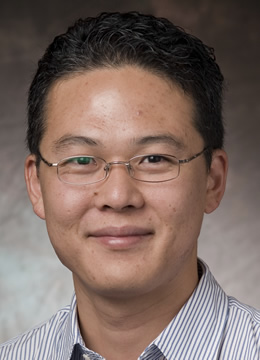
TAE HOON KIM, PHD
My laboratory has a general interest in understanding nuclear processes and mechanisms that segregate, fold and unfold chromosome fibers and disease-causing changes that disrupt normal location, arrangement, and interpretation of the human genome. In particular, we are studying the cis-regulatory architecture of nociceptor genomes that underly normal and chronic pain processes.
View Dr. Kim’s lab at UT Dallas
— Return to Top —
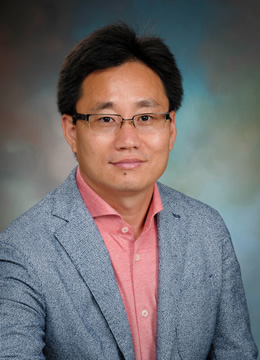
YU SHIN KIM, PHD
Dr. Yu Shin Kim, graduated from Johns Hopkins University SOM and finished his postdoctoral training at Johns Hopkins University SOM. He is currently a tenure-track assistant professor of Neuroscience and Cell Biology at the University of Texas Medical Branch (UTMB) where it is known for its strong group in pain research. His research focuses on the function and regulation of sensory modalities including pain, itch, and gentle touch, with special emphasis in understanding the cellular and molecular mechanisms of pain by studying neural circuit activities evoked by pain in normal and disease conditions like chronic pain, chronic itch, and other disease-mediated neuropathy.
View Dr. Kim’s page at UT Health San Antonio School of Dentistry
— Return to Top —

PHILLIP KRAMER, PHD
Our lab is interested in the central and peripheral mechanisms related to why women report chronic and neuropathic more often than men. We particularly focus on orofacial pain maladies. One such malady is post-herpetic neuralgia. Initial infection of a herpesvirus strain called varicella zoster virus results in chickenpox. Herpes zoster “shingles” results from reactivation of the varicella zoster virus. One type of orofacial pain that is commonly treated by oral surgeons is post-herpetic neuralgia because orofacial pain occurs in over 20% of post-herpetic neuralgia patients. Varicella infection of the eye also leads to further complications such as eye damage in a disorder termed herpes zoster ophthalmicus. Women report post-herpetic pain more often than men. Treatment of pain and damage due to varicella virus is difficult since opioids are often not effective and because herpes zoster is only partially controlled by vaccination. In the current studies we have developed an animal model that develops neuropathic orofacial pain for up to eight weeks following varicella infection and females show greater sensitivity than males. With this model we expect to determine mechanisms by which varicella causes orofacial pain and the mechanisms resulting in the sex difference. These discoveries are expected to provide targets for treatment; treatment could also utilize viral vectors like herpes simplex virus.
View Dr. Kramer’s page at Texas A&M University College of Dentistry
— Return to Top —

QING LIN, MD, PHD
Dr. Lin obtained an MD from Fujian Medical University, PhD from Shanghai Fudan University in China, and Postdoctoral Training from University of Texas Medical Branch at Galveston, USA. Dr. Lin is currently an Associate Professor with tenure in the Department of Psychology, the University of Texas at Arlington. He has also received honors as a Visiting Professor from several universities and hospitals internationally. Dr. Lin is an active neuroscientist in the fields of pain neurobiology, neurotoxicity and neurodegenerative disorders. His research has been funded by US NIH, China National Science and Science & Technology funds. He has published more than 70 research articles. Dr. Lin has a good track-record of participation in several collaborative projects. Currently, he and his collaborative colleagues are working on developing a new animal model of a chronic migraine headache. He is also conducting an existing collaborative research on the pain caused and developed by a demyelinating disorder.
View Dr. Lin’s page at The University of Texas at Arlington
— Return to Top —

STEPHEN MARTIN, PHD
A native of New Mexico, Stephen Martin received his BS in chemistry from the University of New Mexico, whereupon he went to Princeton University where he received his PhD. After postdoctoral years at the University of Munich and Massachusetts Institute of Technology, he joined the faculty at The University of Texas at Austin in 1974, where he currently holds the M. June and J. Virgil Waggoner Regents Chair in Chemistry. His research interests lie broadly in organic and bioorganic chemistry and chemical biology. He is renown for his work in a broad arena of the synthesis of biologically-active heterocyclic natural products and for studies of energetics and structure in protein-ligand interactions. More recently he has focused on the design and synthesis of small molecules that may be used as molecular probes to study biological function and as potential leads to treat various diseases, including cancer and neurological disorders by an exciting and fundamentally new approach. For example, he and his team have discovered novel molecules that modulate the sigma 2 receptor (◻2R) and have promising properties in animal models of Alzheimer’s disease and traumatic brain injury where they improve performance in learning and memory tests. These compounds also lower levels of proinflammatory cytokines, reduce axon degeneration and improve neuron and oligodendrocyte survival. Other compounds have favorable properties in animal models of alcohol dependence and neuropathic pain. He has received a number of awards, including the NIH Career Development Award, an American Cyanamid Academic Award, the Alexander von Humboldt Prize, an Arthur C. Cope Scholar Award, a Japanese Society for the Promotion of Science Award, a Wyeth Research Award, the International Society of Heterocyclic Chemistry Senior Award, and most recently the Ernest Guenther Award in the Chemistry of Natural Products (ACS); he is also a fellow of the American Association for the Advancement of Science. He is the regional editor of Tetrahedron for the Americas and Chairman of the Executive Board of Editors of Tetrahedron Publications. He has published over 315 scientific papers in primary journals together with several patents, reviews, and book articles. He is also co-author of the popular undergraduate laboratory book Experimental Organic Chemistry: A Miniscale and Microscale Approach. On the all too rare occasions that he is not engaged in professional activities, he enjoys music, travel, fly fishing, skiing, photography, wine, and being with his wife and daughter.
View Dr. Martin’s lab at the University of Texas at Austin
— Return to Top —

VOLKER NEUGEBAUER, MD, PHD
Dr. Neugebauer is a physician scientist who received his MD and PhD degrees from The University of Würzburg, Germany. After clinical training in Neurology and postdoctoral training in Physiology, Pharmacology and Neuroscience at the University of Würzburg and at The University of Texas Medical Branch (UTMB) at Galveston, TX he became faculty at UTMB and served as Vice Chair in the Department of Neuroscience & Cell Biology and as Director of the Neuroscience Graduate Program. In 2014 he assumed his current positions at TTUHSC.
The focus of Dr. Neugebauer’s research over the past two decades has been on synaptic and cellular neuroplastic changes in higher brain functions and dysfunctions. The analysis of emotional-affective and cognitive brain mechanisms of pain centered on amygdala interactions with cortical areas is a key contribution of Dr. Neugebauer’s work to the field of pain research and neuroscience. Close interactions between pain and anxiety/depression, and dysfunction of reward systems as a shared mechanism of pain and addiction disorders provide important opportunities for interdisciplinary translational research. As Founding Director of the new Center of Excellence for Translational Neuroscience and Therapeutics at TTUHSC Dr. Neugebauer has been establishing collaborative research projects to explore brain mechanisms of neuropsychiatric disorders, alcohol abuse and addiction disorders, neurodegenerative disorders and epileptogenesis. These research projects use an integrative multidisciplinary approach of state-of-the-art systems and slice electrophysiology, multi-photon imaging, optogenetics, viral vector strategies, genetic tools, pharmacology and innovative behavioral assays.
View Dr. Neugebauer’s page at Texas Tech University Health Sciences Center
— Return to Top —
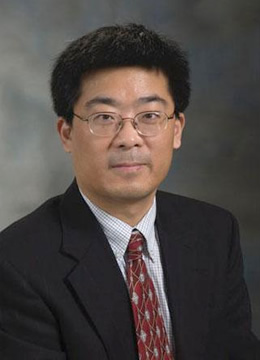
HUI-LIN PAN, PHD
Dr. Hui-Lin Pan received his medical and graduate degrees and practiced medicine for 3 years in China. He worked as a postdoctoral fellow at the University of California, Davis and conducted basic research in cardiovascular and neurophysiology. Before moving to University of Texas MD Anderson Cancer Center in Houston, Dr. Pan’s laboratory studied the role of primary afferent nerves and spinal cord dorsal horn neurons in pain transduction and transmission at both Wake Forest University and Pennsylvania State University. Currently, his laboratory is focused on neuroscience studies such as the epigenetic basis of chronic pain, molecular mechanisms regulating voltage- and ligand-gated ion channels, and synaptic plasticity underlying the development of hypertension and chronic pain. In addition, he is interested in understanding the analgesic mechanism of G protein-coupled receptor agonists and opioid tolerance.
View Dr. Pan’s profile at the University of Texas MD Anderson Cancer Center in Houston
— Return to Top —
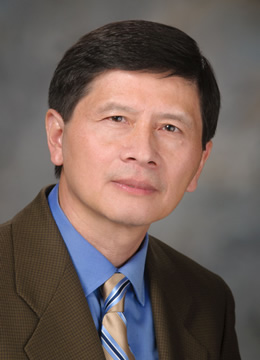
ZHIZHONG PAN, PHD
Dr. Pan is a Professor in the Department of Pain Medicine at the University of Texas MD Anderson Cancer Center. Dr. Pan received his PhD from the Vollum Institute, Oregon Health Sciences University in 1993 and his postdoctoral training in the Department of Neurology at the University of California at San Francisco between 1993-1997. He was an Adjunct Assistant Professor at the UCSF before joining MD Anderson as an Assistant Professor in 2000. Dr. Pan acquired extensive training in cellular neurophysiology, molecular neurobiology and system behavioral neuroscience from his pre- and post-doctoral research activities.
Research in Dr. Pan’s laboratory focuses on functions of opioids, covering topics from opioid signaling and analgesia, mechanisms of chronic pain, opioid addiction, and interactions of opioids’ analgesic and rewarding actions. A variety of current techniques are employed at the gene, molecular, cellular and behavioral levels to understand the mechanisms underlying opioid effects on pain and addiction, including epigenetic, optogenetic and viral transgene techniques in rodent models of chronic pain and opioid addiction. His team’s recent work investigates how negative emotion disorders may impact the development of chronic pain and how repeated opioids act in the process of pain development and behaviors of opioid abuse.
View Dr. Pan’s profile at the University of Texas MD Anderson Cancer Center
— Return to Top —

JOSEPH PANCRAZIO, PHD
Dr. Pancrazio’s research focuses on the development and demonstration of novel neural interface technology for both in-vitro and in vivo applications. The laboratory leverages advances in microscale fabrication to create new devices capable of in vitro assays that capture bioelectrical activity. The laboratory is interested in function-based or phenotypic assays involving cultured nociceptors on microelectrode arrays for neuropharmacological applications.
View Dr. Pancrazio’s page at UT Dallas
— Return to Top —

T. DORINA PAPAGEORGIOU, PHD, MHSC
The areas of focus in my laboratory — Investigational Targeted Brain Neuro-therapeutics — funded by the McNair Medical Institute, include the neuro-rehabilitation of visual cortical blindness, speech/motor impairment and chronic pain as a result of traumatic brain injury, stroke, brain tumor, neurodegenerative disease, and pain syndromes.
We use a novel intervention to provide cortically targeted neuro-rehabilitation, called real-time functional MRI neurofeedback to induce reorganization in cortical and subcortical pathways. Patients undergo rneurofeedback in real time to upregulate or downregulate the activity of intact cortical and/or subcortical areas in conjunction with the continuous presentation of visual stimuli inside the MRI environment with the goal to restore or reorganize lesioned pathways associated with vision, speech, or pain. The modulation in the Blood-Oxygen-Level-Dependent (BOLD) signal intensity is achieved by feeding back to the patient the magnitude of mean BOLD signal intensity of his/her intact cortical area during the presentation of a stimulus in real-time. The hypothesis is that such training engages Hebbian mechanisms that modulate the activity of intact cortical areas with the goal to improve performance.
View Dr. Papageorgiou’s page at Baylor College of Medicine, Houston
— Return to Top —

YUAN BO PENG, MD, PHD
Dr. Peng obtained his PhD under William D. Willis, Jr., MD, PhD, postdoctoral training at Johns Hopkins Medical Institute under Professors James Campbell and Richard A Meyer, and at the Division of Intramural Research at the National Institute of Dental and Craniofacial Research (NIDCR) under Drs. Kenshalo, Gracely, and Ruda, Dr. Peng has been extensively trained as electrophysiologist for both in single neuron and single teasing fiber recording. The ongoing research is to identify the LFP neural signatures for pain by developing algorithms to extract the neural signature for pain treatment.
View Dr. Peng’s page at UT Arlington
— Return to Top —

TED PRICE, PHD
Theodore (Ted) Price completed his BS in Neuroscience at The University of Texas at Dallas in 1997 and then his PhD from UTHSCSA in 2003 where he worked on mechanisms of cannabinoid analgesia with Ken Hargreaves. He then went to McGIll University where he was a postdoctoral fellow in the lab of Fernando Cervero from 2004 — 2007. At McGill Ted worked on mechanisms of spinal pain amplification and developed an independent line of investigation on local translation control in nociceptors as a mechanism for rapid deployment of new gene expression to alter excitability. In 2007 Ted moved to The University of Arizona School of Medicine where he started his independent laboratory in the Department of Pharmacology. There he obtained funding from The Rita Allen Foundation and The National Institutes of health on diverse projects aimed at understanding molecular mechanisms that cause pain to become chronic. In 2014 Ted moved back to his hometown of Dallas, TX to the University of Texas at Dallas where he is the Director of the Systems Neuroscience Program in the School of Behavioral and Brain Sciences. His lab continues to be interested in molecular mechanisms driving the transition to chronic pain with an increasing focus on drug development for chronic pain disease modification. He has won numerous awards including the John C Liebeskind Early Career Scholar Award from the American Pain Society and The Patrick D. Wall Young Investigator Award from the International Association for the Study of Pain. Ted serves on editorial boards for leading pain and neuroscience journals and is a standing member of the Somatosensory and Chemosensory Study Section for NIH.
View Dr. Price’s page at UT Dallas
— Return to Top —

SHIVANI RUPAREL, PHD
I am an Assistant Professor at UT health San Antonio. My focus of research is cancer and pain. Specifically, I am interested in peripheral mechanisms for how tumor cells control the activities of sensory neurons. My current focus is identifying mechanisms by which oral cancer tumors produces pain as well as determining the interactions of tumor cells and peripheral sensory neurons at the site of primary tumor development. Besides, I am also interested in studying the differences between painful and non-painful cancers and elucidating the differential regulation of cancers that produce pain at the primary site versus cancers that produce pain when they metastasize to the bone. We use a variety of techniques in the lab including: Primary tissue culture techniques as well as culturing of established cell lines; Cell proliferation and clonogenic assays, in vitro invasion assays, immunohistochemistry and anatomy, ELISAs and RIAs, Flow cytometry, Next-gen sequencing, mouse xenograft models; Pharmacological models including real-time calcium imaging, high-throughput calcium assays; Rodent behavioral assays including von Frey threshold, radiant heat test, automated mechanical threshold with dynamic aesthesiometer, feeding behavior assays, conditioned place preference test; and electrophysiology including single fiber extracellular recordings.
View Dr. Ruparel’s page at the University of Texas Health San Antonio School of Dentistry
— Return to Top —
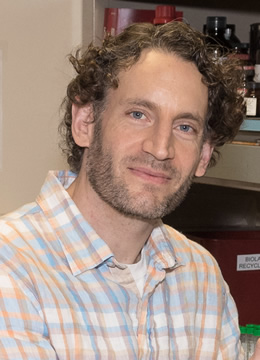
JAMES SAHN, PHD
Sahn has over 15 years of experience in synthetic-organic chemistry and has been involved in medicinal chemistry projects for the past 5 years. Much of his focus has been on the design and synthesis of drug-like heterocyclic scaffolds and the subsequent medicinal chemistry optimization of “hits” for improved affinity, selectivity, and pharmacokinetic attributes. Sahn’s projects have spanned the areas of chemical biology, medicinal chemistry, and pharmacology. Sahn and his team are currently working on developing preclinical lead compounds for traumatic brain injury (TBI), Alzheimer’s disease (AD), neuropathic pain, and addiction.
View James Sahn’s page on LinkedIn (UT Austin)
— Return to Top —

FENG TAO, PHD
Dr. Feng Tao is an Associate Professor in the Department of Biomedical Sciences at Texas A&M University College of Dentistry. His research interests focus on the central mechanisms of pain transmission and analgesia. His lab is conducting pain research on several ongoing projects, including an NIH-funded study of mechanisms underlying stress-induced pain chronification, descending control of orofacial pain, and pathogenesis of migraine headache.
View Dr. Tao’s page at the Department of Biomedical Sciences at Texas A&M University College of Dentistry
— Return to Top —

MASATAKA UMEDA, PHD
Dr. Umeda is an assistant professor of kinesiology and a director of the Exercise and Health Psychology Laboratory at The University of Texas at San Antonio. Dr. Umeda received his PhD in kinesiology from the University of Wisconsin-Madison, and completed his postdoctoral research in Clinical Neurophysiology at the University of Colorado-Denver Anschutz Medical Campus.
Dr. Umeda’s research examines physical activity and pain, and consists of the two primary lines of research: One is to examine the relationship between physical activity and central pain modulatory processing in diverse groups of individuals (e.g., chronic pain patients, individuals of different activity levels, individuals of racial/ethnic minorities, etc.), whereas the other is to examine the role of physical activity in fibromyalgia symptoms. To pursue the two lines of research, Dr. Umeda typically conducts laboratory studies using various psychophysiological techniques (e.g., quantitative sensory testing of pain, cold pressor test, heart rate variability, etc.).
View Dr. Umeda’s lab at The University of Texas at San Antonio
— Return to Top —

SVEN VANNESTE, PHD
Dr. Sven Vanneste is an Associate Professor in the School of Behavioral and Brain Sciences at The University of Texas at Dallas as well as an Honorary Research Professor in the School of Medicine at the University of Otago, New Zealand. Sven is particularly interested in studying specific chronic pain disorders such as chronic back or leg pain, complex regional pain syndrome, painful neuropathies, fibromyalgia and phantom pain and to develop novel invasive and noninvasive neuromodulation treatments for these disorders. Dr. Vanneste was one of the leading researchers involved in the development of burst spinal cord stimulation, a little-to-no paresthesia therapy that delivers closely-spaced pulses of electrical energy to a patient’s spinal cord to manage chronic pain. He further developed a new therapy to treat fibromyalgia using occipital nerve stimulation and continues to do research to better understand the underlying mechanism of neuromodulation for chronic pain. His lab is currently conducting research to develop a new pain therapy for patients diagnosed with Gulf War Illness, Syndrome IIII.
View Dr. Vanneste’s profile at UT Dallas
— Return to Top —

TERRY WALTERS, PHD
Edgar (Terry) Walters earned his BA in biology at Reed College (1974) and PhD in physiology at Columbia University (1980), working on learning and memory mechanisms with Nobel laureate Eric Kandel. He joined the University of Texas Medical School at Houston faculty in 1982 and became Professor in 1996.
He is the current Director of the Gulf Coast Consortium for Translational Pain Research. His research has emphasized a comparative and evolutionary approach to identifying fundamental neurophysiological and cellular mechanisms of neuronal plasticity related to bodily injury and persistent pain. Early discoveries utilized injury-detecting sensory neurons (nociceptors) in a large marine snail, Aplysia, and included the first demonstration that memory-like alterations are induced in nociceptors by convergent intrinsic and extrinsic signals linked to bodily injury. Other discoveries about the mechanisms and biological functions of nociceptor plasticity have been made in squid and rats.
Much of his group’s current research is on mechanisms of chronic pain caused by spinal cord injury in rodents, which he and his colleagues first showed depends (surprisingly) as much upon continuing hyperactivity in primary nociceptors as it does upon central alterations, and showed that chronic, ongoing activity is generated largely within the nociceptor’s cell body in the dorsal root ganglion. In collaboration with other groups, he is investigating alterations in excitability mechanisms and cell signaling pathways that maintain persistent nociceptor hyperactivity, the signals that induce this hyperactivity, and whether these mechanisms contribute to other forms of long-lasting pain, including pain from peripheral nerve injury and from chemotherapy.
View Dr. Walter’s page at the University of Texas Health Science Center at Houston
— Return to Top —

QING YANG, PHD
Dr. Qing Yang is an Assistant Professor in the Department of Integrative Biology and Pharmacology at UT McGovern Medical School. The long-term research goal in her lab is to understand molecule and cellular mechanisms underlying chemotherapy and traumatic injury-induced neuropathy with a major goal to identify potential therapeutic targets that can be used to effectively treat chemotherapy- and traumatic injury-induced complications. At present, Dr. Yang seeks to deconstruct the role of ion channels in spinal cord injury (SCI)-induced secondary degeneration and chemotherapy-induced peripheral neuropathy (CIPN) to gain new insight on the treatment.
View Dr. Yang’s profile at the University of Texas Medical Branch at Galveston
— Return to Top —